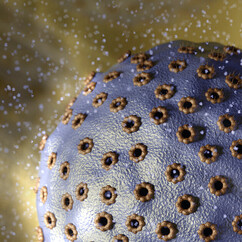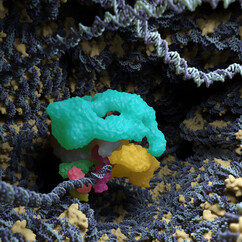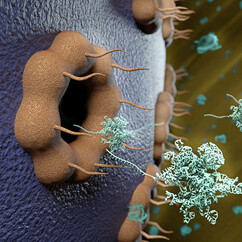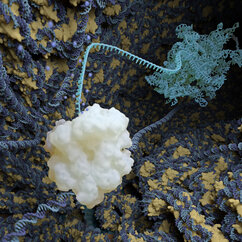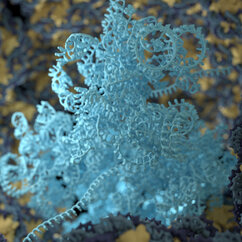Video illustrates gene expression in unprecedented detail
In a new animation video, structural biologist Clemens Plaschka takes viewers on a journey into a cell’s nucleus to witness gene expression. The video draws on recently published data and shows these fundamental processes in greater detail and with higher accuracy than ever before.
DNA makes RNA and RNA makes protein. While more nuanced in practice, this principle has been dubbed the "central dogma of biology" and has been textbook-knowledge for decades. Although generally well-understood, gene expression is a very complex process that involves multiple steps. Molecular biologists around the world study this foundation of life in ever growing detail. A new video produced by the IMP with an animation by science communication company biolution is now setting a new standard in illustrating gene expression.
"Our visualisations use scientific data from public databases, but this data is becoming increasingly complex and so we also rely on advice from active scientists", says Stefan Grünert, managing director of biolution. He adds: “The interactions at the Vienna BioCenter led to discussions with Clemens Plaschka, who has contributed to some key studies on the structure and function of very large and dynamic complexes visualised in our animation. We feel very lucky and are extremely grateful for this opportunity.” Biolution’s managing directors Iris and Stefan Grünert have backgrounds in molecular biology themselves and plan to take the company further into the scientific visualisation field.
Central dogma revisited
Even before the official launch, lecturers from different universities were impressed by the complex visuals and already requested permission to use the video in their teaching. Such high interest demonstrates the importance of RNA regulation for understanding cell biology. Clemens Plaschka, group leader at the IMP since 2018, studies RNA structure and function using cryo-electron microscopy. "This method, which was awarded a Nobel prize in 2017, has allowed rapid progress in the field of molecular biology", says Plaschka. “In a cryo-EM study, we typically obtain one or more snapshots of a biological process. Animations such as this are an engaging way to summarise and conceptualise the findings of multiple studies.”
The idea for the video was sparked by a related project featuring the lab of Plaschka’s colleague Johannes Zuber, which is also due to premiere.
"Additionally, we hope to convey to young scientists our fascination with understanding fundamental mechanisms of life, such as gene expression", concludes Plaschka. The Vienna BiocCenter offers great opportunities to young scientists, from master’s research to the international PhD Programme to postdoc positions. Our research groups welcome applications for PhD student positions and from pre- and post-doctoral scientists, who wish to apply state-of-the-art technologies such as cryo-electron microscopy to understand important biological mechanisms.
Eukaryotic gene expression: following the message
About the IMP
The Research Institute of Molecular Pathology (IMP) in Vienna is a basic biomedical research institute largely sponsored by Boehringer Ingelheim. With over 200 scientists from 40 countries, the IMP is committed to scientific discovery of fundamental molecular and cellular mechanisms underlying complex biological phenomena.
About biolution
biolution is a scientific communications and consulting company at the Vienna BioCenter, by scientists for scientists. Founded in 2002, the team specialises in tailored solutions supporting researchers in the life sciences in their increasingly complex communication tasks, from grant writing, to events, to molecular animation. http://www.biolution.net
About the Vienna BioCenter
The Vienna BioCenter is a leading life science hub in Europe, offering an extraordinary combination of research, business and education in a single location. About 1,800 employees, 90 research groups, 24 biotech companies, 1,300 students, and scientists from 70 countries create a highly dynamic and stimulating environment. Both IMP and biolution are part of the Vienna BioCenter. http://www.viennabiocenter.org
